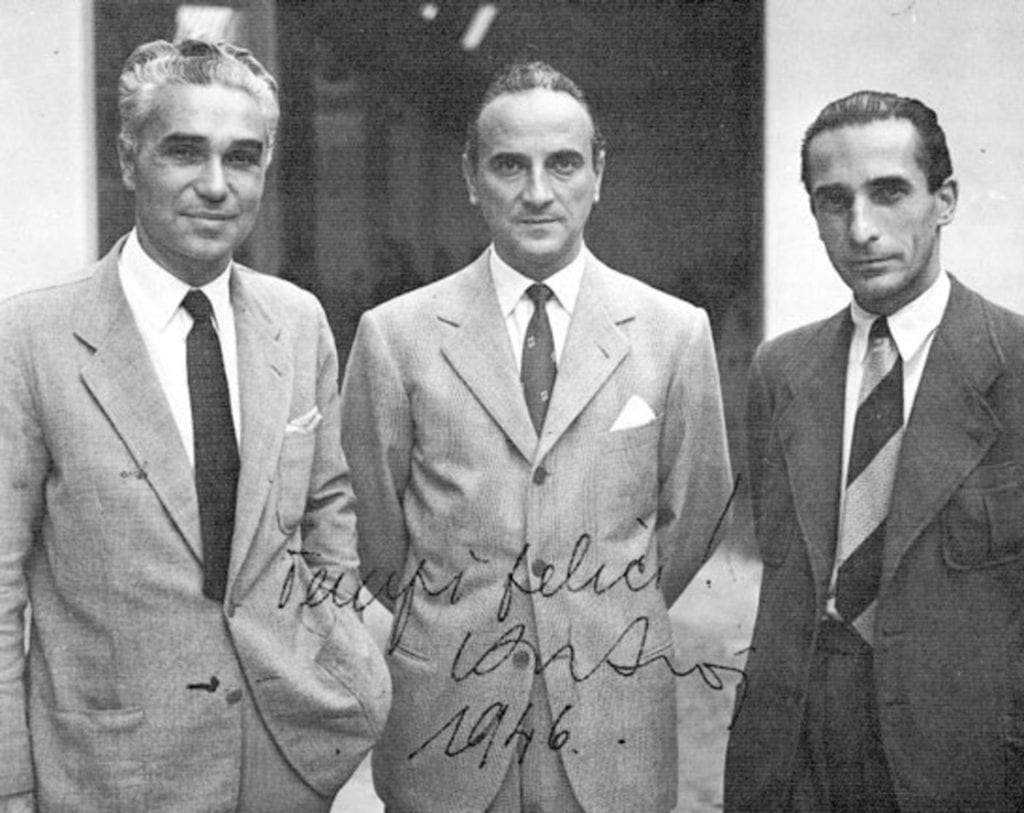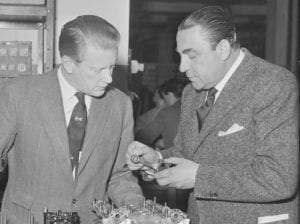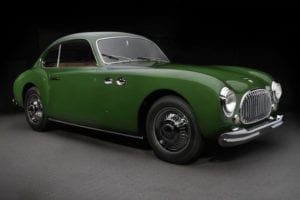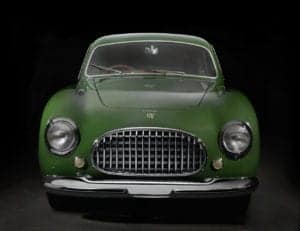Piero Dusio: A Sweeping Mid-Century Saga of Money, Power, Success and Failure

From left to right: Piero Taruffi, Piero Dusio, and Giovanni Savonuzzi.
This week’s historical feature will be the first story written by one of our museum volunteers posted to our website. Revs is very fortunate to have 130 volunteers contributing over 20,000 hours per year to the organization. The volunteers work alongside staff in the library, workshop, and spend countless hours on the museum floor guiding visitors on tours and sharing their knowledge of the collection with our patrons. After many hours of study and preparation, some become learned docents who share an even deeper knowledge of the cars and the stories they represent in small group tours.
The volunteers also produce a monthly internal newsletter that focuses on collection cars and other automotive themed stories that serve as both entertainment and educational tools. The cars from the Miles Collier Collections at Revs also provide an opportunity for volunteers to adopt a specific car and to prepare historical features following many hours of research within our library and archives. These stories have historically been kept within the volunteer group, but are so well researched and presented, that we want to share them with our Revs audience. Enjoy!
By Morris Cooper
At the age of 17 Piero Dusio was a successful professional soccer player in Turin with the world-famous Juventus Football Club, but a knee injury ended his sports career at the age of 24. Searching for a new occupation, Dusio landed a sales job for a Swiss textile company, and in 1927 he opened his own business. By the 1930’s Dusio’s ventures made him one of the richest and most powerful men in Italy. Among his most lucrative enterprises, bestowed upon him by dictator Benito Mussolini, was exclusive uniform manufacturer for the Italian military and, in parallel, supplier of canvas to the Germans. His company was called Consorzio Industriale Sportivo Italia, abbreviated to Cisitalia.
The increasingly wealthy entrepreneur devoted himself to automobile racing in the 1930s, entering the Italian Grand Prix and the Mille Miglia. As the war was drawing to a close in 1944, Dusio assembled his friends designer and carriage builder Battista Pininfarina, Fiat scion Gianni Agnelli, and automotive design engineer Dante Giacosa to plan the post-war manufacture of an affordable single-seat race car using Fiat components. The result was the Cisitalia D46, a lightweight but rigid space-frame racer. It had a modest 62-horsepower engine but immediately proved itself worthy on the track.

Between 1946 and 1949 Dusio assembled a post-war “dream team” of drivers for the Cisitalia D46 including Tazio Nuvolari, Piero Taruffi, and Louis Chiron. But Dusio had even greater ambitions than an 1100 cc race car. He wanted to hire the world’s best engineer to further his automotive efforts, but as it happened, “the best” remained locked up in prison in Dijon, France.
By July 1946 Ferry Porsche had been released from captivity, but his father, Ferdinand, and brother-in-law, Anton Piëch, were still imprisoned by the victorious Allies. The personal connection between Dusio and the Porsche family was former Austrian motorcycle racer and the Porsche representative for Italy, Carlo Abarth, whose wife had been Piëch’s secretary.

Together with engineer Rudolf Hruschka, Abarth arranged meetings between the two companies in late 1946 in Austria. Even then Ferry Porsche’s freedom of movement was severely restricted by the Allies.
In February 1947 in the wake of the meeting with Porsche, Cisitalia ordered designs for a mid-engine Grand Prix car, a 1500 cc sports coupe, a diesel tractor and a hydraulic turbine. In return, Porsche would get royalties for every Porsche-designed product sold by Cisitalia.
Abarth and Hruschka began working as employees of Cisitalia with engineer Robert Eberhan-Eberhorst who had developed the world-beating Auto Union race cars in the 1930s. Internally, the Cisitalia Grand Prix car was known as the Porsche 360. It was designed in Gmund, Austria, with a plan to build six at the Cisitalia factory in Turin in 1947 and 1948.

In the meantime, Dusio used his French racing driver (and WW II Resistance fighter) Raymond Sommer as a go-between to pay a very large, undisclosed sum to the French government for the release of Dr. Porsche and Anton Piëch from prison on August 1, 1947. This was not just a goodwill gesture by Dusio. The “ransom” payment he made was deducted from the Porsche expense budget.
The Cisitalia (Porsche 360) Grand Prix car was incredibly ahead of its time with these distinguishing features:
- Chrome-moly space-frame chassis
- Mid-mounted flat 12-cylinder engine with four overhead camshafts and two superchargers
- Dry-sump lubrication and front-mounted oil cooler
- 400 horsepower at 10,500 rpm
- Five-speed sequential shift transmission (said to be the first of its kind in an automobile)
- Mid-engine with rearward-mounted transmission and differential
- Four-wheel drive with front-drive disconnect available to driver
Perhaps not surprisingly because of these remarkable innovations, the cost and complexity of the Grand Prix car began to spiral out of control. Only one was ever completed.

Meanwhile, Dusio intended to create a sports coupe based on the D46 and had employed a brilliant young Fiat aeronautical engineer, Giovanni Savonuzzi. Together with Pininfarina, Cisitalia created one of the greatest post-war automotive designs, the Cisitalia 202.
The 202 has been aptly described as “organic, natural and elegant” with “…. a conscious effort to disguise its man-made complexity with simplicity and clean lines, making the car look like one element.”
The 202 was the first car to be purchased and featured in a major museum’s collection (at New York’s Museum of Modern Art in 1951), where it was declared to be one of the eight most beautiful cars ever made. Many regard the 202 as the first modern GT car.
As bills began to pile up in the summer of 1948, Dusio made plans to move his company, persuading the Argentine government that his continued connection with Porsche would revolutionize the car industry in South America. The company was called Autoar, (Automotores Argentinos) and was financed by the Peron government. In fact, Eva Peron drove a 1947 Cisitalia 202 Cabriolet.

By early 1949, the financial position of Cisitalia in Italy was precarious, with assets in receivership and workers suing for unpaid wages. But unfortunately for Dusio, his move to Argentina caused Porsche to sever its ties. Neither Autoar nor a refinanced version of Cisitalia in Italy were particularly successful subsequently.
In January 1960, the Porsche factory racing team arrived in Buenos Aires to compete in the 1000 Km race with three RSK Spyders. While in Argentina, Porsche Racing Manager Fritz Huschke von Hanstein learned that the innovative Cisitalia/Porsche Grand Prix car was for sale, and he purchased it on behalf of Porsche. Its serial number was CIS-001, but it was shipped back from Argentina to Zuffenhausen as a Porsche, to a country the car had never seen.
Moving to Argentina may have temporarily saved his business, but Dusio never again enjoyed the success he had experienced in Italy during those heady post-war years. He remained in Argentina manufacturing pumps, electric motors and industrial equipment until his death in 1975.

